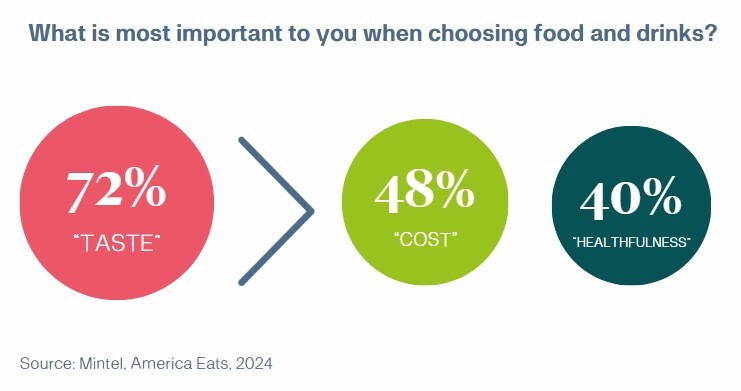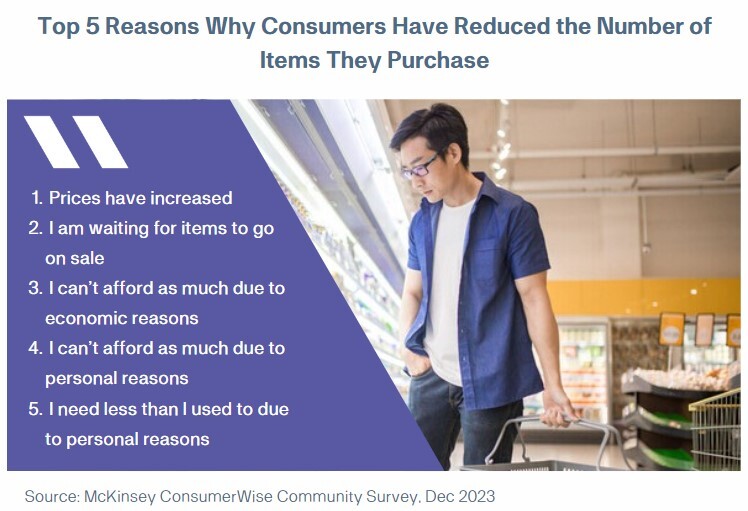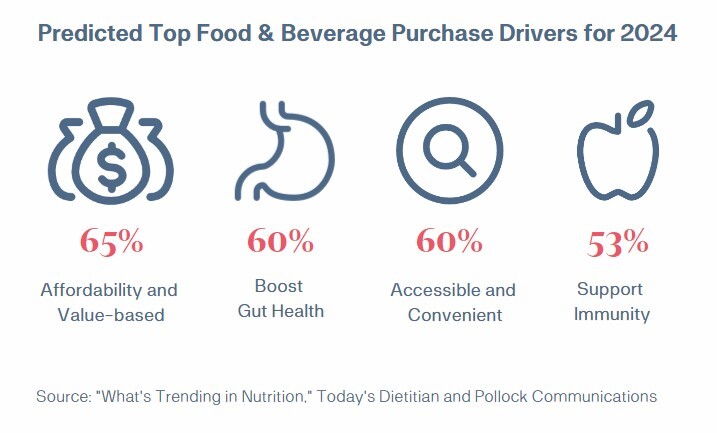Consumer Purchase Driver Trends for Food & Beverage
By Louisa White, Senior Manager, Consumer Insights and Analytics
Deciding how to target your potential consumers, or even deciding who they are, is challenging. What do they want from food and beverage products? What motivates that trial purchase and, more importantly, repeat purchases?
In today's macroeconomic climate, consumers are navigating a complex landscape where health and financial considerations are deeply intertwined. The United States economy continues to outperform expectations, and, on paper, all the economic indicators are doing well—unemployment is low, inflation is coming down, wages are going up, and the S&P index continues to hit all-time highs.
The challenge is that there's always a delay; a bump in the stock market, for example, is not likely felt by the average consumer right away. In addition, COVID was a huge disruptor that pushed health concerns to the fore. Not to mention, the last two years of global issues, like wars in Europe and the Middle East, have created additional supply chain uncertainty.
The bottom line, however, remains the same: people must eat. Let’s examine some top trending consumer purchase drivers and reveal how our expertise can help you focus your food and beverage product innovation where it counts.
Taste — for the typical consumer, nothing matters more
When anyone asks me what the number one consumer purchase driver is for food and beverage, I don’t have to check the data to answer: Taste is always king. But, of course, I can supply the data to back that up. According to a recent Mintel survey, 72% of American consumers rank taste above all other factors when selecting food and drinks.

As you can see, taste easily trumps cost and healthiness, even though these are prime concerns.
Of course, you don’t know what something tastes like until you try it. If you capture a consumer in their moment of decision, someone who perhaps has thought, “I want to eat healthier tonight,” you have to meet their expectations for flavor, not just what’s on your ingredients label or what on-pack claims you make. The vast majority of consumers, if they discover it tastes good and it's healthy, then you start getting that repeat purchase.
Affordability — Sometimes the bottom line is truly the bottom line
I touched on a few promising economic trends earlier. But, the fact remains that the average consumer faces a rising cost of living and lingering inflation, notably in the grocery store. This can’t help but make affordability a top priority, especially with the 18–24 crowd.1 Credit card balances are up, and savings are down. Not surprisingly, many who face financial hardship are forced to prioritize cost over health in their food choices.2
Cost is such a potent motivator that even a survey of Registered Dietician Nutritionists revealed “affordable and value-based” as their top prediction for purchase drivers in 2024, ahead of gut health, convenience, and immunity support.3
Not only are they opting for budget-friendly foods, but they’re also buying fewer items when shopping. Interestingly, they’re grocery shopping more often but coming home with less in their bags. This suggests fewer impulse buys and being more selective about shopping sale items and waiting for the best deals.

Of course, there’s cost, and then there’s value. If you can manufacture not just affordable food products but ones that provide cost-effective solutions to other consumer demands, like health and convenience benefits, that’s a great way to win over fiscally challenged shoppers.
Health and Wellness — Food as “medicine” continues to thrive
Cost and taste requirements aside, a strong desire remains for foods that support wellness and provide a sense of good health. Even before COVID, people were starting to care more about their health and connect their food with their well-being, not just among a niche of health-conscious consumers but in the mainstream, as well. We especially saw younger generations showing heightened awareness about their health compared to their parents, being more proactive versus reactive.
The COVID pandemic, however, rapidly evolved the landscape of health and wellness. Now, all generations are a lot more proactive about how they're going to age and just being healthier in general. That includes mental and physical health; there is a greater understanding of the relationship between food and all-over health.
Brands that can communicate value when highlighting the health benefits of their products are likely to resonate with consumers trying to balance their budgets with their dietary goals.
Fiber — This vital nutrient is in a league of its own for consumers
Gut health, specifically, is of huge importance to consumers. As I said previously, it scored high on a survey of RDNs who were asked to predict the top purchase drivers in 2024. Gut health ranked second, with 60.4% pegging it as a critical trend for this year.4

It’s an interesting area because it means different things to different people. Fiber is a constant with gut health, though, particularly as it relates to weight management, energy levels, and digestive health.5 And, while people don't necessarily understand the science, they know that research shows their microbiome, which thrives on dietary fiber, is important to tangible things like immunity.
Fiber is, of course, something we know a lot about at Tate & Lyle. Our STA-LITE®, PROMITOR®, and Euoligo® ranges of soluble fibers provide us great flexibility when it comes to formulating (or reformulating) your product to catch this consumer wave.
Convenience — Can you make lives easier and food taste better?
Our fast-paced lives show no signs of slowing down. And when you’ve got to make every second count, convenience matters. Consumers seek ready-to-eat meals, meal kits, and snacks that fit seamlessly into their routines.
Unfortunately, just as there exists an inverse relationship between cost and health in food choices, so, too, are the most convenient portable foods seldom the healthiest selections. This is starting to change, though, and we’re seeing more CPG companies incorporating a health aspect into their convenience products. That includes not just on-the-go snacks and meal replacements but also at-home items like frozen meals for the microwave.
A very telling statistic emerged in the early days of COVID: “83% of global consumers are influenced in their purchase by how well a product… aligns with their time and money constraints.”6 There is no reason to imagine that has changed in the past four years. If this is your market, our team can help you check all the boxes, from ease to nutrition to shelf-life.
Sustainability — Consumer know their choices (and yours) make a difference
Once the domain of only the most socially aware consumers, sustainability is table stakes at this point for manufacturers. While the consumer is no longer necessarily looking for an on-pack callout, they expect companies to be practicing and contributing to fixing the problem.
Younger generations, in particular, prioritize sustainable practices—they're the ones who will have to deal with global warming when they're older. They seek brands that demonstrate a commitment to environmental stewardship, fair labor practices, and responsible sourcing. When Gen Z and Millennial customers believe a brand cares about its impact on people and the planet, they are 27% more likely to purchase it than older generations are, a clear measure of sustainability’s power to drive buying decisions in this group.7
With the easy availability of information (and misinformation) on social media, transparency has become incredibly important to consumers. If a brand shifts to be more transparent about its ingredients, while there will be a hurdle to clear and break through the noise of getting the most clicks, it will be worth the effort. Today’s digital-savvy young consumers see being ethically sound as “cool.” And what higher status is there for youth?
What’s Heading Your Way?
Being as immersed as I am in consumer data and analytics, people often ask me what I see coming our way in food and beverage.
I am optimistic that costs will come down in the next year as supply chains shore up and inflation eases. This will allow consumers to breathe a collective sigh of relief and then focus on health even more. Connected to that, I see the gut health trend accelerating. It was already there before COVID; it was just much smaller. Think about kombucha, which was a new type of product for many— it took off, and people started talking about probiotics, and then they started talking about prebiotics. It’s bound to be a dynamic and exciting market sector.
I envision sustainability becoming huge, and Tate & Lyle can fulfill that as a sustainable supplier. Looking at brand trust, I'm curious to see what technologies come out, like AI, to aid transparency campaigns. There's been a lot of backlash for generative AI, but I believe it’s truly innovative and will help people be more productive.
Lastly, science will play an increasingly important role in how food is produced, and products are developed—we all have to continue to be prepared for that. And no one knows that better than us. It’s right there in our Purpose statement: Transforming lives through the science of food.
Final Thoughts
Understanding and aligning with consumer purchase drivers is crucial for success in the food and beverage industry. No matter how much effort you put into your product, it won’t sell if it doesn’t address consumer need states, and desires. As the key trends of taste, affordability, health and wellness, fiber, gut health, convenience, and sustainability continue to motivate consumer choices, it falls to you to adapt and innovate to stay relevant. By focusing on these key areas, businesses can meet consumer demands and foster loyalty through repeat purchases. Fortunately, you don’t have to go it alone.
At Tate & Lyle, we specialize in helping companies like yours create food and beverage products that resonate with consumers. Contact us today to learn how our extensive formulation expertise can help you develop solutions your consumers will love and drive your success now and down the ever-changing road.
Sources:
1) Mintel, How America eats, 2022
2)Mintel, How America eats, 2024
3)"What's Trending in Nutrition," Today's Dietitian and Pollock Communications
4)"What's Trending in Nutrition," Today's Dietitian and Pollock Communications
5)Mintel, Consumer Approach to Eating, 2022
6)GlobalData, Trend Sights 2020
7)Harvard Business Review, September 2023

